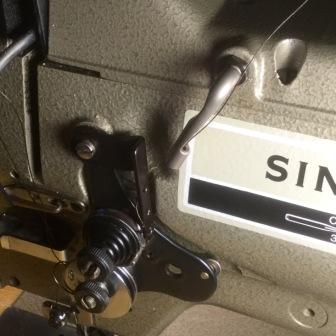-
Posts
98 -
Joined
-
Last visited
Content Type
Profiles
Forums
Events
Blogs
Gallery
Everything posted by georgeandgracie
-
Bill Williams appears to have had a change of heart about selling the machine. He turned down my $600 offer and did not reply when I asked if he wanted to counter-offer or even if he wanted to stay firm on the $700 price. Perhaps he will reconsider but meanwhile I think it's best to keep looking.
- Show previous comments 30 more
-

A week+ of this misery? Why can't they come up with some way of fixing it faster than that?!
There was a pack of No. 23 needles in the drawer. They look huge but they seem to work. I can get by with those for a while.
Alberoni said this machine was "head only" but it came with a table and a servo-ish motor. Not much of a servo. I'm going to get a real one.
It came with a zipper foot rather than a general-purpose one. Seems odd. If this isn't a walking foot machine, why is this a two-part foot?
Where they hide the stitch length adjustment, I have yet to figure out. The booklet that passes for a manual does not discuss this little matter.
The good news is that the machine sews shelter tent fabric without puckering!
-

This afternoon I tried making a few things "for real" - not just dinking around on scraps. And I have come to the conclusion that this is a psychotic machine. I hate it! One thing after another! I can't control the machine and the fabric all at the same time. Yesterday it seemed like things weren't weird but today they are. Maybe it's the pressure of needing to produce at item without flaws. My level of frustration is such that it's hard to verbalize everything that's gone wrong, but I'll try.
1. The machine stalls on heavy seam crossings that Fussbudget handles with some coaxing. Example: a corner in a filter twill apron, where a narrow-hemmed armhole edge (3 layers of fabric) meets a two-inch turned-under hem at top of the apron (a whole bunch more layers). So I guess the aprons will have to wait until Fussbudget returns.
2. Reverse is finicky and that big wide lever requires what seems like an absurd amount of pressure, enough to reduce my ability to manage the fabric. If I don't get everything just right - fast and smooth, no hesitation, no slowing down or stopping to keep from overshooting the reversing point, no finessing, pretty much just hanging on for the ride, whee! - the machine stalls at the end of the forward travel. The needle freezes and thread gets bound up in bobbin case. I don't yet know how to disassemble this horizontal type of bobbin assembly to get the threads out. Surely it shouldn't be necessary to lean on the reverse lever with one hand and turn the wheel with the other - leaving no hands to control the fabric - in order to have some control over the reversing operation? Is this why they made the 111 with no reverse? To keep people from getting into trouble?
3. Machine clanks a lot. Is that normal?
4. Bobbin winder (on the table) doesn't feed evenly in spite of adjustments. There's some kind of bobbin winding setup attached to the top of the machine but it doesn't engage when power is applied.
5. Machine came with a zigzag foot which doesn't grip very well so the fabric has opportunities to get squirrely as soon as my attention is diverted by the machine's antics.
6. Maybe it's just me, but it seems like the foot is squeezing things out of alignment. I suppose that is an adjustment issue.
7. If the machine had a real servo instead of this sort-of-servo motor that Alberoni installs, things would probably be better because speed could be taken out of the equation. One of my Instagram friends sews waxed canvas tool rolls, too. He bought a machine, I think a Consew 206RB, from Alberoni, and had to ditch the serv-oid because it didn't slow the machine enough. He bought a real servo from Toledo Industrial Sewing Machines (the Cowboy leather machine guy) and swears by it, so I ordered the same model this morning. Two or three days until it gets here, probably.
8. Are these enormous size 23 needles part of the problem?
9. And so on and so forth! Yet here you are, in great discomfort, and I'm yowling about a silly sewing machine.
-

Eric, has the crisis finally passed?



